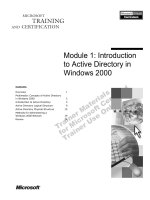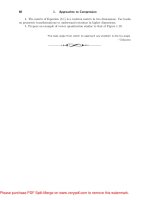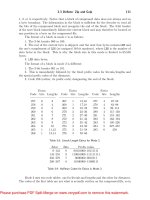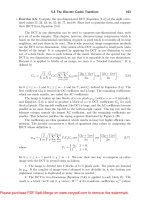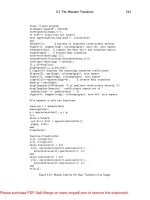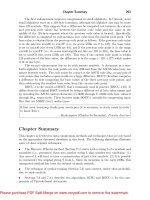Tài liệu A Strategic Approach to Cost Reduction in Banking - Achieving High Performance in Uncertain Times docx
Bạn đang xem bản rút gọn của tài liệu. Xem và tải ngay bản đầy đủ của tài liệu tại đây (640.46 KB, 16 trang )
A Strategic Approach to
Cost Reduction in Banking
Achieving High Performance
in Uncertain Times
Rethink Traditional Cost Strategies 2
Strike the Right Balance 3
Avoid Arbitrary Cuts 4
Transform Cost Reduction 5
Industrialize Operations 8
Getting Started 9
Collaborating with Accenture 10
Looking Ahead 12
Contents
1
Senior banking executives face a vexing dilemma. In
this difficult economic environment, there is great
urgency to reduce costs and improve efficiency. But
cutting indiscriminately or too deeply may severely
hamper the ability to grow revenues when the economic
outlook improves.
In Accenture's view, arbitrary cost reduction—based on
rationales of "sharing the pain equally across the organi-
zation"—is no longer sufficient, and risks cutting muscle
as well as fat. Instead, financial institutions need to take
a more strategic approach by viewing cost-cutting as
part of a broader efficiency effort. Balancing short-term
tactical cost reductions with longer-term strategic cost
initiatives will leave banks much better positioned for
future high performance.
This approach can yield cost reductions up to 20 percent,
help variabilize a high fixed-cost base, and enable banks
to weather the credit storm. Just as important, this
strategy aligns with banks' efforts to simplify processes
and systems, standardize products and facilitate market
differentiation. Those attributes are what we consider
the blueprint for a high-performance bank.
This brochure examines how banks can solve the
dilemma by taking out costs in a judicious way that
also supports future growth.
2
Rethink Traditional Cost
Strategies
For the first half of this decade, banks largely
operated in an extraordinarily benign envi-
ronment of low interest rates, rising home
prices, expanding loan volumes and robust
economies—all of which created opportuni-
ties to generate substantial organic growth
and shareholder value. Most banks were able
to steadily improve their cost-to-income
ratio during that period.
But today, high energy prices, sluggish
economies and the continuing fallout from the
credit crunch have put a damper on the banking
industry globally. Many financial institutions
have posted huge write-downs, particularly in
North America and Europe. Japan's major banks
have reported weak earnings results, due in
part to the subprime mortgage meltdown in
the United States. The International Monetary
Fund estimates that losses related to the credit
crisis could approach $1 trillion.
The short-term outlook isn't hopeful. Many
North American and Western European finan-
cial institutions, for example, are under severe
liquidity pressures due to loan losses, slowing
or even negative revenue growth due to the
weak housing market, tighter credit standards
and sluggish economies. Fortunately, many
banks in the Asia-Pacific region, as well as
those in central and eastern Europe have been
largely shielded from the turmoil. But few
banks, regardless of location, have escaped the
major impact of the current economic down-
turn: the far higher cost of capital and signifi-
cant increase in funding costs.
Efforts to stem the tide by raising capital
and additional dividend cuts haven't entirely
succeeded. Increasingly, banks are turning to
internal costs savings including headcount
reductions. Tens of thousands of bank staff
have lost their jobs in the past year, and further
layoffs have been announced.
But traditional cost reduction strategies that
worked in previous banking slowdowns, such
as in the early 2000s, won't suffice this time
because banks face:
• Uncertainty as to when the bottom of this
downturn will be reached.
• Unprecedented levels of operational risk.
• Highly complex operating models which
make it difficult to reduce costs quickly
and sustainably.
It is clear that the recent cycle of easy credit
and growth in lending and revenues has
masked serious underlying problems. The
widespread focus on growth, combined with
lack of discipline around operating models,
product streamlining, margin control and
organizational structures, has led many banks
to build up highly disparate and complex
operating models. This, in turn, has resulted
in high cost bases as well as inflexible and
duplicative operations.
On a more positive note, the current envi-
ronment continues to offer global banks
attractive growth opportunities, particularly
in emerging markets such as Brazil, Russia,
India and China. Therefore, global banks with
a presence in emerging markets must be
judicious in their cost reduction initiatives,
so that their growth agendas do not suffer.
Deep cuts in the number of IT personnel,
for example, need to be properly examined
since expansion into emerging markets
typically requires significant investment in
IT capabilities and support.
3
Strike the Right Balance
The cost-cutting and efficiency agenda will
vary among regions and from bank to bank.
For institutions most affected by the crisis,
particularly those in North America and the
United Kingdom, tactical cost reductions are
the immediate priority. On the other hand,
many banks in the Asia-Pacific region are
pursuing a broader efficiency agenda focused
both on decreasing costs and building capa-
bilities to support growth. Some European
banks, such as those in Italy and Spain, are
also emphasizing efficiency and growth.
To achieve high performance, banks need
the right balance between short-term
tactical cost decreases such as headcount
reductions, and longer-term strategic cost
initiatives such as streamlining processes
or outsourcing certain noncore functions
such as learning, human resources or
finance and accounting. Banks that pursue
only traditional cost reduction programs
will achieve cost benefits quickly. But in
the long run, that approach will leave them
unable to sustain those cost reductions,
resulting in a competitive disadvantage.
Suppose Bank A consolidates multiple mort-
gage processing centers in an effort to
quickly extract costs. Bank B, its competitor,
also consolidates its processing centers and
in addition, reengineers its lending processes
and migrates them to a standard platform,
and enters into a business process outsourc-
ing arrangement for post-closing functions,
which enables a variable cost base. When a
stronger market returns, Bank B's costs will
remain in check, but Bank A's are likely to
rise again. By balancing short- and long-term
objectives, Bank B has achieved competitive
advantage over its rival and is on the path
to high performance.
The key is for banks to evaluate their busi-
ness model now against scenarios ranging
from best case to worst case, and to act
before the full impact of the credit crunch
plays itself out. Many banks continue to
have relatively strong short-term earnings
momentum, but the outlook remains highly
uncertain. This leaves a small window of
opportunity to tackle the size and flexibility
of the cost base.
Precisely how banks do this will depend on
their operating model and strategic priorities.
But whatever route they choose, the long-term
winners will be those that begin stabilizing and
building for the future by adopting flexible
operating models to accommodate threats
and opportunities as they emerge.
Leading banks realize the importance of
taking out costs and investing the savings in
strategic programs that will help them bring
products to market more quickly, interact
with customers more effectively and gain
competitive advantage.
As part of its Basel II compliance effort, a
European bank spent substantial amounts in
the past two years building a new technology
platform to track, measure and manage its
credit risk exposure. The bank completed the
project well within its allotted program budg-
et. But instead of terminating the commit-
ment at that point, it used the remaining
budget plus an additional investment to devel-
op better insight into managing credit risk
limits for its customers. As a result, the bank is
aiming to reduce the amount of risk capital on
its balance sheet (thereby decreasing its cost
of capital) and also hoping to price its cus-
tomers far more effectively. For a relatively
small investment, and by leveraging capabili-
ties built for a compliance program, the bank
is seeking to cut its cost of capital and poten-
tially improve revenues on its balance sheet.
It may be necessary to take a counterintu-
itive approach to cost cutting. Rolling out
new products, for example, intrinsically
would appear to be a sound business strat-
egy. But, particularly in a weak economy,
investing in new products may just add
unwanted complexity to the product port-
folio without generating profits. For some
banks, it may make sense to shrink their
product portfolio and channel the savings
into more strategic, longer-term programs
such as credit risk management.
Process automation is another undertaking
with which few would argue. But instead
of automating processes on a piecemeal
basis, banks may find that, upon analyzing
their processes from end-to-end across
the enterprise, several processes can be
eliminated altogether.
Sometimes, across-the-board cutbacks
don't go far enough. A uniform 10 percent
reduction across expense budgets makes
little sense when a bank's lending function
could withstand deeper cuts due to sharply
depressed loan demand.
4
Avoid Arbitrary Cuts
With the onset of an economic slowdown,
the temptation is to reassure investors by
cutting indiscriminately—10 percent across
all departments, for example (Figure 1).
However, banks emerging most successfully
from previous downturns were not neces-
sarily those making the deepest cost cuts.
Instead, the winners focused on optimizing
their cost base.
Traditional Tactics Differentiating Tactics
Cut costs
Conserve cash, and eliminate / delay
discretionary spending
Forecast more often
Reduce headcount
Take advantage of the downturn
to justify unpopular moves
Communicate lower earnings
expectations
Cut the right costs
Direct discretionary spending to only those programs that add value
Continue an accurate and meaningful forecasting process
Target headcount reductions at specific sub-organizations and / or
low performers
Consider adding specific headcount at lower rates than would
otherwise be required
Continue value-driven moves justified by their impact on
shareholder return
Expand the quality of communications to more fully describe value-
drivers and the expected impact of differentiating tactics
Figure 1:
In a downturn, most banks pursue traditional,
instead of differentiating tactics
5
When implementing tactical measures—such
as headcount reductions—to deliver a quick
payback, banks should reinvest the resulting
savings in strategic initiatives that provide
longer-term benefits (Figure 2).
This is an approach which Lloyds TSB has
been using successfully for several years.
Lloyds recently announced that "The Group's
programme of productivity initiatives has
continued to deliver significant benefits,
improving underlying cost efficiency and
creating greater headroom for investment
in the business," with net cost reductions
in 2007 of £145 million (US$290 million)
and a further £103 million (US$206 million)
reinvested in further productivity program
initiatives
1
.
As Figure 2 shows, a tactical cost-cutting
approach will quickly yield substantial savings
which rapidly level off after the first year.
A bank taking a more strategic, transforma-
tional path won't receive a similar quick
benefit in year one because it plows the
savings into optimizing its operating model,
consolidating systems and employing sourcing
where appropriate to variabilize its cost base.
By funding these longer-term initiatives,
however, the bank enjoys a far greater uplift
in benefits in the following years, compared
to the tactical approach.
Transform Cost Reduction
1. Lloyds TSB Group Annual Report and Accounts 2007.
Year 1 Year 2 Year 3
• Investment portfolio review
• Contractor / supplier rationalization
• Expenses clampdown
+ $500m
to $1b
- $50m to
$100m
Net Benefit
(Benefit - Cost)
• Strategic organizational design
• Offshoring costs
• Outsourcing of non-core functions
• Strategic operating model
• Platform replacement / consolidation
Reinvesting tactical
benefits into
transformational
initiatives
Transformational
Tactical
=
Figure 2:
Traditional vs. transformational cost reduction
(Illustrative: Mid-size bank investment / return profile)
6
The path to high performance starts by under-
standing your bank's cost anatomy. Banks' cost
structures are not spread evenly across opera-
tions. Figure 3 is an example of the cost distri-
bution of a typical universal bank, based upon
Accenture's research and experience with
European financial services companies.
Figure 3 demonstrates that, contrary to con-
ventional wisdom, the back office-with only
14 percent—is not the primary source of
banks' cost base. Automating and making the
back office more efficient will undoubtedly
help, but not fully solve, banks' cost chal-
lenges. Senior executives looking to remove
significant costs must also focus on distribu-
tion operations (with nearly two-thirds of
the cost base) and enterprise-wide functions
(21 percent of costs). While in most cases,
banks would be well advised to aggressively
cut costs in enterprise services and informa-
tion technology, they should proceed more
cautiously in attacking front office costs.
Of course, banks' cost distribution varies
widely from region to region, and even within
regions. But the point is clear: high-perform-
ance banks will take a broad and intelligent
view when cutting costs to be competitive
both now and in the future. Banks in Italy,
Spain and other European countries that have
made substantial progress in streamlining their
back offices and IT operations are focusing
on making distribution more efficient. North
American banks, on the other hand, are still
targeting inefficiencies in the back office.
Segment Management
Brand Management
Channel Integration and Management
Marketing, Sales and Servicing
Customer
management
Customer
pricing
Product
aggregation
Product
pricing
Third party
management
Service
integration
Deposit / cash
management
Lending
Investment Insurance
Payments
Product
development
Product
accounting
Document
management
Knowledge
management
Finance Human Resources Purchasing Legal and compliance
IT application IT infrastructure
Risk
Distribution
Marketing Hub
Products
Cross Product
Enterprise
Source: Accenture analysis of major European bank data, 2007
~65%
~14%
~21%
Figure 3:
Costs distribution across universal bank’s functions
Take a Broad View of Costs
7
There is a clear imperative to address the cost
base without impacting revenue generation.
A winning strategy, for instance, might be
to streamline back-office and IT operations,
and redeploy the savings in front-office
efficiency initiatives to enable more consis-
tent customer service across channels, pro-
vide tools and support for customer-facing
staff, and enhance self-service channels.
Based upon our experience working with the
world's leading banks, we have identified six
key ways that high-performance banks
demonstrate efficiency:
• Lean operational model:
Minimal management layers, clearly defined
roles and extensive use of shared s
ervices
to eliminate duplication of activities.
• Rationalized product portfolio:
Significant reduction of product portfolio,
r
ationalized product portfolio with
standard components and reusable product
features, coupled with a clear understanding
of product profitability.
• Optimized sourcing and procurement:
Utilization of offshoring and outsourcing
to variabilize costs while reducing fixed
cost base, and tight control of external
expenditures.
• Streamlined processes:
Broader use of image and workflow
technology to automate manual,
paper-based processes; minimization
of process duplication, strong culture
of end-to-end process ownership and
continuous improvement.
• Effective customer experience:
High levels of customer self-service for
simple sales and service transactions;
sales and marketing activities focused
on most profitable customers, and differ-
entiated service based on customer
profitability and future value.
• Simplified technical infrastructure:
Simplified IT architecture and supporting
applications to reduce total cost of
ownership and boost responsiveness
and flexibility
, and aligning IT spending
closely to business strategy.
By examining a bank’s cost anatomy against
these attributes, the opportunities and scale
for cost reduction initiatives can be mapped
across the entire organization. Accenture’s
approach to efficiency contains a portfolio
of tools and assets—the Accenture High
Performance Bank Framework—that can
help a bank achieve high performance. We
believe there are significant opportunities
to reduce costs in a transformational way
across banks’ operations, realizing as much
as a 20 percent reduction in operating costs
over two years.
For example, up to 10 percent of a bank's
distribution cost base can be eliminated-
with a 5 percentage point reduction in cost-
to-income ratio—through greater reliance
on self-service channels, rationalization
of contact centers and other initiatives.
Procurement is another area where significant
savings can be generated. With the appropriate
combination of automation and self-service,
consolidation of suppliers and selective out-
sourcing and offshoring, a universal bank can
reduce its purchase spend by between 6 and
8 percent (the rough equivalent of 1.2 to 1.6
percent of revenues).
8
A major European retail bank embarked
upon a bold strategy to reignite future
market share growth, with equal focus on
revenue generation and cost reduction. Targets
for cost reduction were set by analyzing
requirements for market competitiveness
and the level of savings achievable in the
back office.
In light of market pressures, rationalization
of operational activities—a main source of
savings—had to be realized in a quick and
sustainable manner without disrupting
ongoing business.
Accenture was engaged to help drive the
reorganization and cost reduction initiative
as part of a two-year plan. The plan focused
on consolidating shared activities and remov-
ing duplicated or unnecessary processes.
Accenture supported the bank in realizing
its goals by helping to:
• Establish a detailed financial baseline.
• Analyze the financial baseline to identify
consolidation and cost savings opportunities
and develop a common roadmap to help
secure delivery.
• Define and establish a target operating
model for optimized back-office operations.
• Re-engineer key banking processes to
deliver the target model.
• Mobilize and deliver key cost savings
initiatives.
With its newly consolidated back office, the
bank quickly achieved its cost reduction targets
by eliminating duplicate activities, rationalizing
management layers, sourcing and implement-
ing more efficient processes. Further savings
are likely through ongoing optimization. A
carefully managed transformation road map
helped ensure that these changes were deliv-
ered without compromising operational stabili-
ty or customer service, and positioned the bank
to meet aggressive growth targets.
Positioning for Growth through Smart Cutting
Industrialize Operations
Taking a balanced approach to cost cutting
requires banks to develop an operating
model that is not only cost efficient, but
can respond quickly to unforeseen market
changes such as further deterioration or an
upward trend. As a result, banks will have
no choice but to industrialize their operations
to combine low costs with high flexibility.
To maintain competitiveness over the long
term, banks need to move progressively
from a substantially fixed-cost base to a
more variable-cost base. This provides the
organization with the flexibility to “dial up”
or “dial down” both cost and capacity in
line with market conditions and strategic
goals. Many banks are already embracing
this strategy through the selective use of
alliances and outsourcing.
Accenture recently worked with a leading
international bank to consolidate, standardize
and ultimately transition parts of its value
chain to lower-cost, off-shore locations. The
new model generated operating cost savings
of up to 60 percent and provided the bank
with the ability to scale up volumes rapidly
at a low unit processing cost.
9
Figure 4:
Cost reduction projects: challenges and keys to success
• Breaking down silos between
business units
• Management culture and
attitudes (we’ve tried it before
and it didn’t work)
• Executing at speed while not
disrupting business-as-usual activity
• Freeing up sufficient investment
capital to tackle structural cost
reduction initiatives that have
a longer payback
• Absolute executive buy-in of
clear financial objectives and
operating model
• An incontestable fact base and
cost baseline
• Ongoing transparency and reporting
of cost and benefits linked to
financial plans
• Clear alignment with existing
investment portfolio
• Robust program structure and
design authority
Execution Challenges Prerequisites for Success
Getting Started
In today’s uncertain and fast-changing
environment, a strategic cost-transformation
project must proceed quickly. Using pre-built
diagnostic tools and assets can shorten
the start-up phase, thereby enabling rapid
identification of cost reduction opportuni-
ties and quantification of the potential
benefits to be gained.
While the journey will be different at each
bank, the initiative should be carefully
planned and encompass the entire organiza-
tion. Execution may well be challenging, in
light of the scale of change required and the
scrutiny by investors, regulators and the media.
Working with a wide range of bank clients on
these programs, Accenture has observed four
common challenges (Figure 4, left side) and five
keys to successful implementation (Figure 4,
right side).
10
Diagnostic Solution Road Map
Validate and identify
further opportunity
areas (workshops with
key operating model
stakeholders across
functions)
Map cost reduction
opportunities to current-
state operating model
Define initiative
sequencing
Detail and prioritize list
of initiatives based on
high-performance models
and client input
Quantify high-level cost / benefit outcome and approach
for each initiative
Define program structure,
governance and funding
Methodology process
Manage stakeholders and build decision-maker buy-in
Steps
Figure 5:
Accenture’s cost reduction analysis approach
Accenture has breadth of vision, deep bank
industry experience and a wide range of tools
to help clients drive their cost transformation
initiatives. We can:
1. Rapidly identify major cost
r
eduction opportunities.
Collaborating closely with a bank's senior
management to ensure executive buy-in,
Accenture can typically complete an initial
diagnosis of potential opportunities within six
to eight weeks. By analyzing products, staff,
customers, process, technology and sourcing,
our diagnostics enable us to take a holistic
view of cost reduction for optimal identifica-
tion and removal of cost.
For example:
•
Can the number of product families be
reduced? Can the efficiency of the product
development pipeline be improved through
Six Sigma?
• Are employee roles aligned to business
needs? Are performance and compen-
sation aligned? Is labor sourced from
low-cost locations?
• Can low-value customers be redirected
to cheaper service channels? Can product
promotions be more effective?
• Can processes be automated, reengineered,
centralized, simplified and/or outsourced?
• Can IT enhancement and maintenance
expenses be decreased and service
levels reduced?
• Is the procurement strategy aligned
to the overall business strategy? Are
supplier relationships optimized?
This initial phase is brief because we have
a proven methodology for creating a trans-
parent cost baseline, a standard hypothesis
based upon our experience and insight, and
benchmark-driven diagnostic tools.
As Figure 5 indicates, the methodology
consists of three steps. The first is a diagnostic
that validates and identifies areas of opportu-
nity, and maps them to the current operating
model. The result of this diagnostic is a "heat
map" and initial hypotheses for addressing
costs. Next is the solution stage, where the
high-level cost/benefits outcome and approach
for each initiative are quantified, enabling the
creation of a prioritized list of cost-reduction
options complete with business cases. The
third step is creation of the road map. The
cost/benefit outcome and approach for each
initiative are finalized and sequenced into an
implementation road map with a balanced
portfolio of short- medium- and long-term
cost-reduction opportunities to sustain the
cost transformation journey.
Collaborating with Accenture
11
2. Accelerate benefits delivery.
We have the experience to shape a holistic
program of change that delivers quick savings
to a bank's bottom line, while at the same
time, ensures that the savings are appropriate-
ly invested in longer-term structural cost
reduction. Accenture has a range of assets and
capabilities that can be used to accelerate
benefits delivery
, including:
• Global Delivery Network:
With more than 60,000 professionals,
Accenture’
s global delivery network is
the world's largest for outsourcing of IT
application development and mainte-
nance, and IT infrastructure.
• Customer Contact Services:
Accenture's virtual global network of
23 centers manages more than 14,000
customer contact agents and services
20 million customers—helping deliver
savings up to 35 percent.
• Credit Services:
Transforms credit operations to improve
processing of consumer loans, leasing,
loan origination, servicing, securitization
and collections—targeting a reduction in
excess of 30 percent in overall operating
costs within the credit lending process.
• Human Resources Services:
Approximately 3,000 professionals
provide HR services to more than 50
clients and their roughly 1.5 million
employees—achieving cost reductions of
20-40 percent and staff effectiveness
improvements.
Procurement is a particularly ripe area to
achieve quick savings that can, in turn,
become the funding mechanism for longer-
term transformation efforts. Purchase spend
is typically 20 percent of revenues for the
banking industry
. Although many banks
have undertaken procurement initiatives,
few have been able to create sustainable
cost differentiation. In 2006-07, banks
typically saved 4 percent in purchase spend
through their procurement initiatives,
compared to global best practice examples
of 15 to 20 percent in other industries.
Accenture has worked successfully with
leading global banking clients to deliver
significant cost reduction in procurement.
Typically, we have helped them achieve
upwards of 15 to 20 percent in savings
through a combination of strategic sourcing,
improved procurement practices, and
effective demand management. Accenture's
procurement practice, unparalleled in its
depth and breadth, is engaged in more than
1,000 procurement projects in 48 countries.
We also work with more than 350 clients
on transformational sourcing programs;
our 7,000 professionals source over $19
billion annually.
3. Assure certainty of outcome.
We stand behind our work by structuring
risk-reward sharing arrangements and taking
responsibility for outcomes where appropri-
ate. Our global assets and capabilities also
allow banks to “switch on” multi-client utili-
ties to accelerate the benefits realized from
their initiatives.
12
Looking Ahead
Banks are at a crossroads. They must continue
to decrease costs and grow revenues in high-
ly uncertain economic times. The actions
they take now to optimize their cost base
and enhance their capacity to respond
quickly and effectively to market change will
shape their ability to achieve high perform-
ance in the future.
Shaving costs through tactical efficiencies
may be a winning short-term strategy, but
beating the competition long term requires
structural change. A good example is the
tendency for banks to be satisfied with
physical consolidation of operations—a
temporary palliative which is rarely suffi-
cient to address structural fixed costs.
Historically, costs start to rise once volumes
recover because the underlying unit cost
drivers have not gone away. Similarly, with
a short-term focus on purchase spend, the
savings typically evaporate when growth
returns and procurement discipline once
again becomes lax.
In Accenture's view, banking industry winners
will be simplified organizations, with varied
sourcing models, increased automation and
customer service targeted to profitability.
As they become more efficient, these banks
will increase market share, leading in turn to
improved shareholder returns.
However, even the winners will not be able
to relax. Achieving high performance as a
low-cost, agile bank will require ongoing
vigilance, not just a single change effort.
Going forward, banks must continually revisit
cost governance and instill a culture focused
on cost management, underpinned by clearly
defined metrics to measure progress.
A leading global investment bank identified
procurement as a key area for simplification,
standardization and improvement. With
approximately 4 million procurement trans-
actions spread across nearly 200 different
business areas each year, the bank wanted
to gain greater control over its annual
spend, streamline and leverage its vendors
more effectively, generate more useable
management information to drive better
decision-making and establish an end-to-
end purchasing management process
supported by leading-edge technologies.
The bank worked with Accenture in a
transformational procurement outsourcing
initiative, covering source-to-pay business
processes, people, a new technology platform
and supporting infrastructure. Accenture was
selected by the bank because it demonstrated
a commitment to building a significant
outsourcing business in procurement,
collaborative approach to working with
clients and proven record of combining
business and IT expertise, strategy and
execution to achieve high performance.
Accenture helped the bank develop and
implement a comprehensive procurement
solution, leveraging Accenture's global
delivery center network in Slovakia, India
and China, as well as its relationship
with SAP.
Accenture provided high-quality service
by using a standardized, scalable and low-
cost utility procurement platform, enabled
by state-of-the-art systems, tools and
processes. The bank and Accenture have
exceeded business case targets for a seven-
year deal within just four years and delivered
15 percent savings in 2007 on vendor
spend of $6 billion.
Case Study: Improve Procurement Operations while Reducing Cost
Copyright © 2008 Accenture
All rights reserved.
Accenture, its logo, and
High Performance Delivered
are trademarks of Accenture.
About Accenture
Accenture is a global management
consulting, technology services and
outsourcing company
. Combining
unparalleled experience, comprehensive
capabilities across all industries and
business functions, and extensive
research on the world's most successful
companies, Accenture collaborates
with clients to help them become high-
performance businesses and govern-
ments. With more than 180,000 people
in 49 countries, the company generated
net revenues of US$19.70 billion for
the fiscal year ended Aug. 31, 2007.
Its home page is www.accenture.com.
